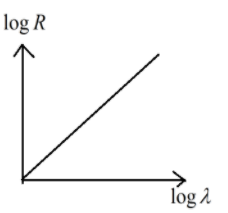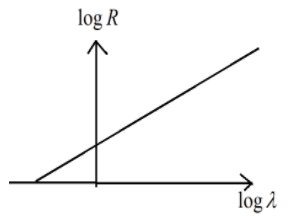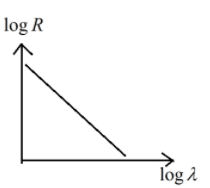
According to the Geiger-Nuttall Law the curve between $\log \lambda $ and $\log R$ will be
A.

B.

C.

D.





Answer
555.6k+ views
Hint: We need to understand the Geiger–Marsden experiment in order to solve this. Geiger and Marsden did a large number of experiments where they observed a beam of alpha particles at a thin foil of a metal piece and measured the pattern of scattering by using a fluorescent screen.
Complete answer:
Geiger and Marsden observed alpha particles are getting reflected in the metal foil in all directions.
Those particles had encountered an electrostatic force far greater than Thomson's model suggested they would, which is nothing but the atom's positive charge was concentrated in a much lesser volume than Thomson imagined.
When Geiger and Marsden shot alpha particles at their metal foils, they found that only a lesser amount of the alpha particles were deflected by more than 90°. Most of them have gone straight through the foil. This says that those tiny spheres of intense positive charge were separated by the empty space. Most particles were passed through the empty space and had no deviation.
So the relation obtained is as follows
\[log\lambda =mlogR+D\]
Rearrange the above equation
\[log\lambda -D=mlogR\]
\[mlogR=log\lambda -D\]
\[logR=\dfrac{1}{m}log\lambda -\dfrac{D}{m}\]
This represents the linear equation of the form $y=mx-c$
Hence option (B) is the correct answer.
Note:
Rutherford thus rejected Thomson's model of the atom, and instead he proposed a model where the atom consisted of most of the empty space, with all its positive charge concentrated in its center in less volume, surrounded by a cloud of electrons.
Complete answer:
Geiger and Marsden observed alpha particles are getting reflected in the metal foil in all directions.
Those particles had encountered an electrostatic force far greater than Thomson's model suggested they would, which is nothing but the atom's positive charge was concentrated in a much lesser volume than Thomson imagined.
When Geiger and Marsden shot alpha particles at their metal foils, they found that only a lesser amount of the alpha particles were deflected by more than 90°. Most of them have gone straight through the foil. This says that those tiny spheres of intense positive charge were separated by the empty space. Most particles were passed through the empty space and had no deviation.
So the relation obtained is as follows
\[log\lambda =mlogR+D\]
Rearrange the above equation
\[log\lambda -D=mlogR\]
\[mlogR=log\lambda -D\]
\[logR=\dfrac{1}{m}log\lambda -\dfrac{D}{m}\]
This represents the linear equation of the form $y=mx-c$
Hence option (B) is the correct answer.
Note:
Rutherford thus rejected Thomson's model of the atom, and instead he proposed a model where the atom consisted of most of the empty space, with all its positive charge concentrated in its center in less volume, surrounded by a cloud of electrons.
Recently Updated Pages
A man running at a speed 5 ms is viewed in the side class 12 physics CBSE

The number of solutions in x in 02pi for which sqrt class 12 maths CBSE

State and explain Hardy Weinbergs Principle class 12 biology CBSE

Write any two methods of preparation of phenol Give class 12 chemistry CBSE

Which of the following statements is wrong a Amnion class 12 biology CBSE

Differentiate between action potential and resting class 12 biology CBSE

Trending doubts
What are the major means of transport Explain each class 12 social science CBSE

Which are the Top 10 Largest Countries of the World?

Draw a labelled sketch of the human eye class 12 physics CBSE

Explain sex determination in humans with line diag class 12 biology CBSE

Explain sex determination in humans with the help of class 12 biology CBSE

Differentiate between homogeneous and heterogeneous class 12 chemistry CBSE




